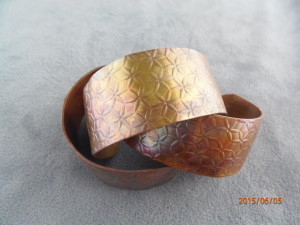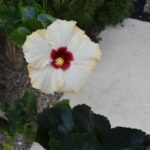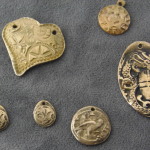Love cuff bracelets–and after my recent two-week walkabout in the UK where I saw lots of ancient jewelry I love cuffs even more. Crown jewels in England and Ireland are spectacular but of a different era and really can’t qualify as inspiration for me at least. Vikings however are a different story. Celts and Vikings have their own versions of jewelry and metalwork that are primitive and highly sophisticated at the same time. A Google search will give you an overview. Much of their metalwork was masculine and warlike and still quite beautiful. The early metal smiths had no electricity, no real torches and had to quit when the sun went down because of lack of light. I also suspect that they were young and mostly male, 10-35 years, because age-related loss of sight would have kicked in shortly after 40 years (She clears throat self-consciously as she adjusts her reading glasses.) Many of these early metal techniques have been lost to time.
These three bracelets were my “getting into the way of it” exercise. Improvements over earlier trial runs include thicker gauge metal because copper is soft and tends to warp after normal use, roller printing to add some way cool texture, and some organized filing to smooth some rough edges and make the bracelets more comfortable. Some pretty torch patina adds a variety of colors and a sealant will protect those colors for long while. They fit a 7 inch wrist.
Some of the more modern jewelry I saw at a craft show in Dublin included some great fused glass–the weather is perfect for that hot, hot, hot craft, and some very feminine and accessory-oriented beading. My definition of accessory beading is beads that complement an outfit or the jewelry wearer as opposed to art jewelry that makes a statement or elaborate beading that dominates clothing.
Copper bracelets









Leave a Reply